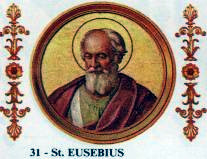Pope Eusebius
|
Pope Saint Eusebius |
|
|---|---|
 |
|
| Papacy began | 18 April 309/310 |
| Papacy ended | 17 August 309/310 |
| Predecessor | Marcellus I |
| Successor | Miltiades |
| Personal details | |
| Birth name | Eusebius |
| Born | Sardinia |
| Died | 309/310 Sicily, Western Roman Empire |
| Sainthood | |
| Feast day | 26 September |
|
Papal styles of Pope Eusebius |
|
|---|---|
 |
|
| Reference style | His Holiness |
| Spoken style | Your Holiness |
| Religious style | Holy Father |
| Posthumous style | Saint |
Pope Eusebius (from Greek Εὐσέβιος "pious"; died 17 August 309 or 310) was the Bishop of Rome from 18 April to his death in 309 or 310.
His pontificate lasted four months, after which, in consequence of disturbances within the Church which led to acts of violence, he was banished by the emperor Maxentius, who had been the ruler of Rome since 306, and had at first shown himself friendly to the Christians. The difficulty arose, as in the case of his predecessor Pope Marcellus I, out of his attitude toward the lapsi.
Eusebius maintained the attitude of the Roman Church, adopted after the Decian persecutions (250-51), that the apostates should not be forever debarred from ecclesiastical communion, but on the other hand, should be readmitted only after doing proper penance. This view was opposed by a faction of Christians in Rome under the leadership of one Heraclius. Johann Peter Kirsch believes it likely that Heraclius was the chief of a party made up of apostates and their followers, who demanded immediate restoration to the Church. Maxentius exiled them both.
Eusebius died in exile in Sicily and was buried in the catacomb of Callixtus. Pope Damasus I placed an epitaph of eight hexameters over his tomb because of his firm defense of ecclesiastical discipline and the banishment which he suffered thereby.
His feast is celebrated on 26 September.
...
Wikipedia
